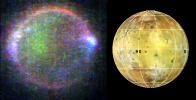
|
1999 in Space Science and Astronomy |
These were the top space science and astronomy news stories in the year 1999, according to the Science News of the Year list compiled by editors of the weekly magazine Science News.
- For the first time, astronomers discovered a planet by observing a slight dimming when it passed in front of its parent star. They also found a system of planets outside our Solar System. Such discoveries brought the total number of known extrasolar planets to 28.
- Photographs suggested three nearby young stars have planets. Stars with an abundance of heavy elements are most likely to spawn planets. Most newborn stars have the potential to make planets.
- NASA didn't hear from Mars Polar Lander after the spacecraft descended through the Martian atmosphere to the Red Planet's south pole. That followed the loss of a sister spacecraft, Mars Climate Orbiter weeks earlier. In the Orbiter flight, important data hadn't been converted from English units to the metric system.
- At Jupiter, Galileo snapped the most detailed photos to date of the volcanically active moon Io.
- Mars Global Surveyor created a detailed three-dimensional map of the Martian surface.
- Astronomers found evidence that the Universe is flat and proposed tests for the theory that the Universe's expansion is accelerating.
- Astronomers identified the galaxies that are sources of several gamma-ray bursts. For the first time, they detected the visible glow of a burst. New evidence indicated that such energetic flashes signal the birth of the darkest objects in the universe. Researchers reported a rapid way to determine the distance to gamma-ray bursts.
- Several new studies could help scientists forecast solar storms from hours to days before they erupt and head toward Earth.
- Researchers calculated the most precise value for the Hubble constant to date. The constant is a measure of the expansion of the Universe and its age. However, another team of astronomers presented evidence that the cosmos is several billion years younger.
- Ghost galaxies, devoid of stars but harboring clumps of matter that is invisible to us, may outnumber the luminous galaxies in the universe. Studies shed light on the distribution and composition of invisible matter in our galaxy.
- Dozens of quasars were discovered, including the most distant one known.
- Scientists discovered a galaxy more distant than any previously measured and found evidence that two other galaxies could be even more remote.
- Space scientists saw no splash when they intentionally crashed a spacecraft into the Moon to look for water.
- The Hubble Space Telescope shut down after its gyroscopes failed. Astronauts flew up in December and repaired the telescope.
- Researchers produced the sharpest and largest radio map to date of the center of our galaxy.
- The cosmos churned out stars at a prodigious rate as far back in time as astronomers could see.
- Astronomers found that supermassive black holes may produce a substantial fraction of the light in the cosmos.
- Researchers discovered an intermediate-weight class of black holes.
- Planetary scientists gathered the best evidence to date that Mars once had a vast ocean.
- Evidence continued to build that Jupiter's moon Europa harbors a subterranean ocean.
- The team, that three years earlier had reported controversial evidence of tiny fossils in an ancient meteorite from Mars, described possible fossils in two considerably younger Martian rocks.
- The 1999 Leonid meteor shower was a showstopper in Europe and Africa. There could be more fireworks in 2001 and 2002. Researchers said the 1998 shower came from dust ejected by a comet 665 years ago.
-
Top of this page
-
Science News magazine:
1999 Astronomy and Space
1998 Astronomy and Space
1997 Astronomy
1997 Space
| SPACE TODAY ONLINE Covering Space From Earth to the Edge of the Universe | |||||||||
| Cover | Rockets | Satellites | Shuttles | Stations | Astronauts | Solar System | Deep Space | History | Global Links |